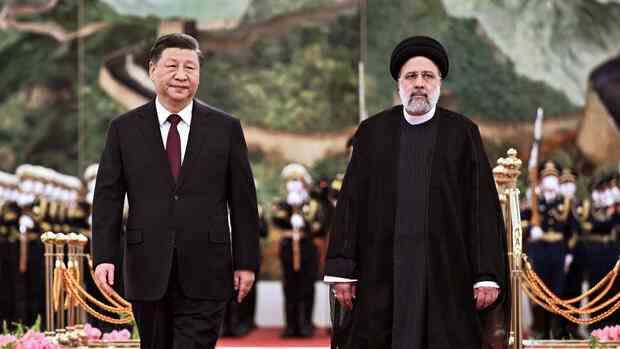Tel Aviv When Iran’s President Ebrahim Raisi and China’s President Xi Jinping meet, it is usually about the partnership between the two countries. It’s about economic cooperation and geostrategic problems. To the surprise of Western observers, another topic was also on the agenda during Raisi’s current trip to Beijing: women’s rights.
Together, Iran and China called on the militant Islamist Taliban government in Afghanistan to stop hindering women in education and work. The government in Kabul should withdraw all discriminatory steps against women, ethnic minorities and other religions, Raisi and Xi demanded in a joint statement on Thursday.
It is remarkable that Iran’s conservative Shiite leadership is campaigning for women’s rights. For months she has faced protests triggered by the death of a young woman in police custody. The Iranian moral police had accused her of not adhering to Islamic dress codes.
According to Western observers, the appeal is an attempt by Tehran to get off the defensive when it comes to women’s rights. In fact, the mass protests by Iranian women in recent months have repeatedly led to the government losing control and called into question the continued existence of the system. The regime cracked down, imprisoned scores of people and imposed the death penalty.
>> Read also: Iran admits detention of “tens of thousands” after protests
The core of Raisi’s three-day visit to Beijing was not about the social upheavals in Iran, but about economic cooperation. At the end of the meeting on Thursday, 20 declarations of intent were signed.
But although both Iran and China have strained relations with the United States and are trying together to counterbalance Washington’s power alongside Russia, it was not a meeting of equals. In Beijing, an economic giant negotiated with a country under massive economic and social pressure. Foreign trade already shows that. While China can maintain global relationships, Iran is limited to two economies: China and Russia.
The Iranian currency has since fallen to a record low. At the end of January, the EU, Great Britain and the USA imposed new sanctions on Iran. According to experts, the sanctions and the political isolation of Iran are a major reason for the devaluation of the rial. The deadlocked nuclear negotiations have unsettled traders in the foreign exchange market.
The regime in Tehran is internationally criticized for the oppression of women. Despite the resistance of the protest movement, he wants to preserve the theocracy.
(Photo: IMAGO/ZUMA Wire)
The composition of the delegation also showed that the Iranians in Beijing were primarily concerned with reviving their own economy. Traveling with Raisi were the governor of the central bank, as well as the ministers for economy, oil, foreign affairs, trade, transport and urban development, and agriculture. Raz Zimmt, Iran expert at Tel Aviv University’s Center for Security Studies INSS, considers the significance of the signed declarations and contracts to be limited. “The options for realizing these are quite limited.”
The visit will “not set anything significant in motion economically,” says Zimmt. From the Chinese point of view, more intensive cooperation with Iran would require Tehran to sign a new nuclear deal and thereby free itself from the sanctions trap. As long as that is not the case, President Xi Jinping does not want to take on any additional problems with the USA.
That is why the 25-year cooperation agreement that was presented with great pomp more than two years ago has hardly resulted in anything concrete. “A breakthrough in relations is not in sight,” confirms Fan Hongda, an Iranian expert at the Shanghai International Studies University.
China’s President Xi Jinping and his Iranian counterpart called on the West to lift sanctions on Iran. This is a prerequisite for advancing the stalled international agreement on Iran’s nuclear program. In addition, the two countries want to expand their military cooperation, for example through “strategic communication between the defense ministries” and the planning of joint maneuvers.
Iran’s President Raisi (left) and the head of the Iranian Nuclear Organization, Mohammad Eslami, at a press conference. They protest that they do not intend to use nuclear technology to build atomic bombs.
(Photo: imago images/ZUMA Wire)
But experts consider the significance of such declarations of intent to be limited. According to Meir Javedanfar from Reichman University in Herzliya, the Gulf countries are economically more important to Xi than Iran. The Chinese could invest there regardless of American sanctions.
At the end of last year, this liaison in Tehran even caused a lot of irritation. The Chinese ambassador to Iran was summoned after Beijing issued a joint statement with the Gulf Cooperation Council questioning Iran’s territorial claims in the Strait of Hormuz.
In Javedanfar’s view, however, China also has a specific goal in mind with the state visit of the Iranian President. Xi was concerned that the Iranians “could get too close to Russia”.
Putin uses Iranian drones in Ukraine. According to the Wall Street Journal, a delegation from Tehran is now in Russia to visit the planned site for a factory. Faster kamikaze drones are to be produced there.
China and Iran held joint naval maneuvers with Russia in the Indian Ocean in January last year. Javedanfars analyses, Beijing wants to show the regime in Tehran that it also has a partner in the People’s Republic in addition to Moscow.
More: With Iran, the West is threatened with a new front
